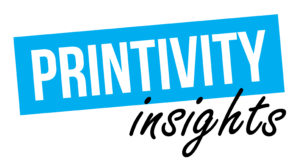Last updated on June 21st, 2024 at 11:00 am
When choosing the paper type for printing booklets (or any print product), it might seem like there is a never-ending list of variables to consider. However, there are 3 questions to ask yourself to help expedite this process!
The three most common paper type finishings are: uncoated, matte, and gloss. All three serve a different purpose depending on the use of the product.

Question #1: What paper coating best fits my booklet’s purpose?
- Uncoated: This paper type is the top recommended paper type for booklets that are intended to be written on (journals, coloring books, workbooks, etc). Uncoated paper is easily written on and will not cause pen ink to smear. This finishing is usually more cost effective than other paper types.
- Gloss: This paper type is usually recommended for designs that contain high amounts of color because it will make the colors stand out more and give a more professional look (product catalogs, photobooks, magazines, etc).
- Matte: This paper type is recommended for booklets that want the professional coated look, but the book contains pages with writable areas or glare from the gloss is not desired (children’s books, calendars, photobooks where less shine is preferred, etc). Matte paper reduces the risk of pen ink smearing when written on with a ball point pen.
Question #2: What paper weight should I choose?
There are 2 factors to consider when choosing the thickness of your booklet’s interior paper: opacity and the number of pages in the booklet.
The opacity in paper is defined as the amount of light that passes through it. Higher opacity paper will not allow much light to pass through the page. Lower opacity paper is more translucent and will allow more light to pass through the page.
If your file’s design contains a lot of images on a white or light colored background, then it would be better to choose a higher weight of paper. If you want an uncoated paper, the thickest option to order is 70 lb Text Uncoated. Otherwise if you want the thickest coated paper weight, 100 lb Text Gloss and 100 lb Text Matte are the best option to decrease the risk of the image showing through on the other side of the page. Your final product will look more expensive and professional if you factor in opacity when choosing your paper weight!
You will also need to consider the number of pages in your file when choosing a paper type. The decision can be simplified once you have chosen the binding type:
- The lower the page count, the higher the paper weight.
- The higher the page count, the lower the paper weight.
When a saddle stitched booklet is 40+ pages, the best paper type that will allow the booklet to lay as flat as possible are the 70 lb and 80 lb text weight. However, when a saddle stitched booklet is 20 pages or less, 90 lb or 100 lb text weight will give your booklet the extra support it needs.
Question #3: What about choosing the booklet’s cover paper?
Saddle stitched booklets have the option of choosing a self-cover. This is when the cover sheet is the same paper type and weight as the interior pages.
It is usually recommended to have a cover sheet for saddle stitched booklets. Cover weight paper is too thick to be folded within the Saddle Stitch binder. So, when a saddle stitched booklet is ordered with a cover weight paper, that sheet will be creased. This will also allow the booklet to lay flatter than if a self-cover was chosen.
Just like the interior paper, there are variations for the cover paper.
If the interior paper of your saddle stitched booklet is 80 lb Text Gloss and you choose self-cover, then the entire booklet will be 80 lb Text Gloss.
Final thoughts on choosing paper for your booklet
After considering these questions when choosing the right paper type, always remember that your personal preference can overrule all other factors.
Order a Hard Copy Proof of your design before proceeding with a full order. Or simply request a Paper Sample Kit so that you can feel the paper for yourself!










